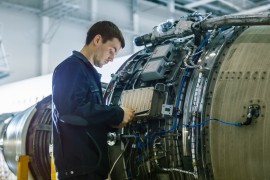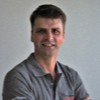PART-66 Training - Aircraft maintenance licence
86% of people interviewed* said they would recommend NOVAE to their friends and family.
Dear Madam, Dear Sir,
Thank you for visiting NOVAE website.
PART 66 Training in ENGLISH is currently not available.
Please check regularly any update on our website.
Kind Regards
NOVAE Training
Teaching objectives
Increase understanding of the regulations regarding the licensing of aircraft maintenance personnel and accredited training centres. Acquire the knowledge necessary for the issuance of Part-66 licences.
Training course content
The training covers the different PART 66 modules according to the chosen License.
The different licenses:
- Maintenance of airplanes with turbine engines (License B1.1)
- Maintenance of airplanes with piston engines (License B1.2)
- Maintenance of helicopters with turbine engines (License B1.3)
- Avionics (License B2)
PART 66 modules
The modules for licenses B1.1, B1.2, B1.3 and B2 are as follows:
- Module 1: Mathematics 32 questions 40 min
- Arithmetic
- Algebra
- Geometry
- Module 2: Physics 52 questions 65 min
- Materials
- Mechanics
- Statics
- Kinematics
- Dynamics
- Fluid dynamics
- Thermodynamics
- Optics (Light)
- Displacement of waves and sound
- Module 3: Basic concepts of electricity 52 questions 65 min
- Electron theory
- Static electricity and conduction
- Electrical terminology
- Generation of electricity
- Direct current energy sources
- Direct current circuits
- Resistance/resistors
- Power
- Capacitance/capacitor
- Magnetism
- Inductance/inductor
- Direct current motor/generator theory
- Alternating current theory
- Resistive (R), capacitive (C) and inductive (L) circuits
- Transformers
- Filters
- Alternating current generators
- Alternating current motors
- Module 4: Basic concepts of electronics B1 20 questions 25 min B2 40 questions 50 min
- Semiconductors
- Diodes
- Transistors
- Integrated circuits
- Printed circuits
- Servomechanisms
- Semiconductors
- Module 5: Digital techniques – Electronic instrumentation B1 40 questions 50 min B2 72 questions 90 min
- Electronic instrumentation systems
- Numeration systems
- Data conversion
- Data bus
- Logic circuits
- Basic computer structure
- Microprocessors
- Integrated circuits
- Multiplexing
- Optical fiber
- Electronic displays
- Electrostatic-sensitive devices
- Software management control
- Electromagnetic environment
- Characteristic electronic/digital aircraft systems
- Module 6: Material and accessory technology B1 72 questions 90 min B2 60 questions 75 min
- Aircraft materials — ferrous materials
- Aircraft materials — non-ferrous materials
- Aircraft materials — composite and non-metallic materials
- 1 Composite and non-metallic materials other than wood and fabric
- 2 Wooden structures
- 3 Fabric covering
- Corrosion
- Fixings
- Threads
- Bolts, studs and screws
- Locking devices
- Rivets for aircraft
- Pipes and connectors
- Springs
- Bearings
- Transmissions
- Control cables
- Electrical cables and connectors
- Module 7 A: Maintenance practices B1 80 questions 100 min B2 60 questions 75 min
- Safety measures — Aircraft and workshop
- Workshop operations
- Tools
- General avionics test equipment
- Design drawings, diagrams and standards
- Play and tolerances
- Electrical cables and connectors
- Riveting
- Pipes and flexible hoses
- Springs
- Bearings
- Transmissions
- Control cables
- Materials handling
- 1 Sheet metal
- 2 Composite and non-metallic materials
- Welding, hard soldering, soft soldering and gluing
- Aircraft weight and centering
- Handling and storage of aircraft
- Disassembly, inspection, repair and assembly techniques
- Abnormal events
- Maintenance procedures
- Module 8: Basic aerodynamics 20 questions 25 min
- Atmospheric physics
- Aerodynamics
- Theory of flight
- Stability of flight and dynamics
- Module 9 A: Human factors 20 questions 25 min
- General
- Human performance and limitations
- Social psychology
- Factors affecting performance
- Physical environment
- Tasks
- Communication
- Human error
- Hazards in the workplace
- Module 10: Aeronautical regulations 40 questions 50 min
- Regulatory framework
- Certifying Staff — Maintenance
- Approved maintenance organizations
- Air operations
- Certification of aircraft, components and devices
- Continuing airworthiness
- National and international specifications applicable for (if not European)
- Module 11 A: Aerodynamics of aircraft, structures and systems B1.1 140 questions 175 min
- Theory of flight
- Aircraft aerodynamics and flight controls
- High-speed flight
- Airframe structures — General concepts
- Airframe structures — Aircraft
- Fuselage (ATA 52/53/56)
- Fuselage (ATA 52/53/56)
- Stabilizers (ATA 55)
- Flight control surfaces (ATA 55/57)
- Nacelles/Pylons (ATA 54)
- Air conditioning and cabin pressurization
- 1 Air supply
- 2 Air conditioning
- 3 Pressurization
- 4 Warning and safety devices
- Instruments and avionics systems
- Instrumentation systems (ATA 31)
- Avionics Systems
- Electrical power (ATA 24)
- Equipment and furnishings (ATA 25)
- Fire Protection (ATA 26)
- Flight controls (ATA 27)
- Fuel systems (ATA 28)
- Hydraulic power (ATA 29)
- Ice and rain protection (ATA 30)
- Landing gear (ATA 32)
- Lights (ATA 33)
- Oxygen (ATA 35)
- Pneumatic/vacuum (ATA 36)
- Water/waste (ATA 38)
- Onboard maintenance systems (ATA 45)
- Integrated modular avionics (ATA 42)
- Cabin system (ATA 44)
- Information systems (ATA 46)
- Theory of flight
- Module 12: Aerodynamics of helicopters, structures and systems B1.1 128 questions 160 min
- Theory of flight - Rotary wing aerodynamics
- Flight control systems
- Blade tracking and vibration analysis
- Transmissions
- Airframe structure
- Air conditioning (ATA 21)
- Air supply
- Air conditioning
- Instruments and avionics systems
- Instrumentation systems (ATA 31)
- Avionics Systems
- Electrical power (ATA 24)
- Equipment and furnishings (ATA 25)
- Fire Protection (ATA 26)
- Fuel systems (ATA 28)
- Hydraulic power (ATA 29)
- Ice and rain protection (ATA 30)
- Landing gear (ATA 32)
- Lights (ATA 33)
- Pneumatic/vacuum (ATA 36)
- Integrated modular avionics (ATA 42)
- Onboard maintenance systems (ATA 45)
- Information systems (ATA 46)
- Module 13: Aerodynamics of aircraft, structures and systems B2 180 questions 225 min
- Theory of flight
- Structures — General concepts
- Auto flight (ATA 22)
- Communication/Navigation (ATA 23/34)
- Electrical power (ATA 24)
- Equipment and furnishings (ATA 25)
- Flight controls (ATA 27)
- Instrumentation systems (ATA 31)
- Lights (ATA 33)
- Onboard maintenance systems (ATA 45)
- Air conditioning and cabin pressurization
- Fire Protection (ATA 26)
- Fuel systems (ATA 28)
- Hydraulic power (ATA 29)
- Ice and rain protection (ATA 30)
- Landing gear (ATA 32)
- Oxygen (ATA 35)
- Pneumatic/vacuum (ATA 36)
- Water/waste (ATA 38)
- Integrated modular avionics (ATA 42)
- Cabin system (ATA 44)
- Information systems (ATA 46)
- Module 14: Propulsion B2 24 questions 30 min
- Turbine engines
- Engine indication circuit
- Start and ignition circuits
- Module 15: Gas turbines B1.1, B1.392 questions 115 min
- Basic principles
- Engine performance
- Intake
- Compressors
- Combustion section
- Turbine section
- Exhaust
- Bearings and seals
- Lubricants and fuels
- Lubrication circuits
- Fuel systems
- Air circuits
- Start and ignition circuits
- Engine indication systems
- Power increase systems
- Turboprops
- Turboshafts
- Auxiliary power units (APU)
- Engine installation
- Fire protection systems
- Engine monitoring and ground operation
- Engine storage and preservation
- Module 16: Piston engine B1.2 72 questions 90 min
- Basic principles
- Engine performance
- Engine construction
- Carburetors
- Fuel injection systems
- Electronic engine control
- Start and ignition circuits
- Intake, exhaust and cooling circuits
- Supercharging / turbocompression
- Lubricants and fuels
- Lubrication circuits
- Engine indication systems
- Engine installation
- Engine monitoring and ground operation
- Engine storage and preservation
- Module 17 A: Propellers B1.1, B1.232 questions 40 min
- Basic principles
- Propeller construction
- Propeller pitch control
- Propeller synchronizing
- Propeller ice protection
- Propeller maintenance
- Propeller storage and preservation
These PART 66 modules are presented in detail with examples of implementation.
To adapt to all profiles, NOVAE offers 3 types of training:
- ERE option: Personal e-learning preparation, targeted refresher course, then examinations with tailored support from qualified personnel throughout your learning;
For greater flexibility, the ERE option is available in 2 versions:
- Condensed (by default): the instruction period is around 8 weeks, modules are taught as close together as possible. The examination is taken at the end of teaching to maintain the benefit from the support.
- Expanded (on request, according to profile): the duration can be increased to up to 6 months. That allows employees to combine training with time in the company.
- ETOS option: E-learning preparation, then examinations (you decide when you are ready);
A switch to face-to-face teaching is possible: if you are not comfortable once your training has started, you can switch over to the ERE option and receive the support of qualified instructors. - Full: full course / practice / examinations
What is the advantage of NOVAE training? Flexible, autonomous training that adapts to your needs (examination credits possible according to certificates acquired in accordance with OSAC regulations).
Send in your information request and our advisors will make contact with you to assess your profile and offer you the best guidance.
Audience
General aviation personnel involved in the supervision of the maintenance of non-complex motor powered aircraft not involved in licensed commercial air transport, with Part-M Subpart F approved maintenance organisations as well as any person working within these organisations. Supervisors, mechanics, trainers, organisational review staff, airworthiness review staff and personnel authorised to develop maintenance programmes for ELA2 aircraft
Method of Distribution and validation of learning
Interactive presentations, practical cases. EASA PART-66 MCQ e-examination
Trainer qualification
Training provided by personnel with operational experience in an aviation organisation and/or within an Authority capable of providing feedback in the field concerned
Level of previous knowledge required
None
Document issued if assessment passed
PART-147 Certificate of recognition
PART-66 Training - Aircraft maintenance licence: questions and answers
How do I get my EASA Part 66 license?
To get your license, delivered by the OSAC, you will have to validate a theoretical part composed of QCM by modules (result >= 75%) and a practical part (experience from 1 to 5 years, according to your qualifications) in PART 145 aircraft centers (in France and abroad). The NOVAE PART 66 training will allow you to validate the theoretical part of the license.
What our trainees say
I highly recommend this training organization, very serious and with a very good support for the trainees. The main trainer listens to the trainees and personally adapts the session to the trainee. The organization is very responsive to the requests of the trainees, you should not hesitate to collaborate with them because by crossing the opinions of the various people I know in my professional circle they are by far the most concerned about the success of the trainees.
Throughout my training, I needed advice, which NOVAE did very well by giving me quick and informed answers. The availability of your staff is quite remarkable and deserves to be known by people who will soon need your services.
I would like to thank you very much for your perseverance and your interest in my file. My project would surely never have succeeded without you. Thank you once again!
Good team, good atmosphere, very very happy. There are small modifications to be made on some courses but the trainers are listening. Honestly it's a good school. I will recommend the center, it is very instructive and I have already started to talk about you.
* Survey conducted from September 1, 2021 to November 30, 2021 among trainees who have started training in one of our centers.

- On request
- Company & individual
- Available in intra-company
- Français
- Available in face-to-face
- 12 maximum
- NOVAE Training centre or in situ
To find out about the terms and conditions, access times or our measures for people with a handicap, please contact us.
 Franck C.
Franck C.
 Francis L.
Francis L.